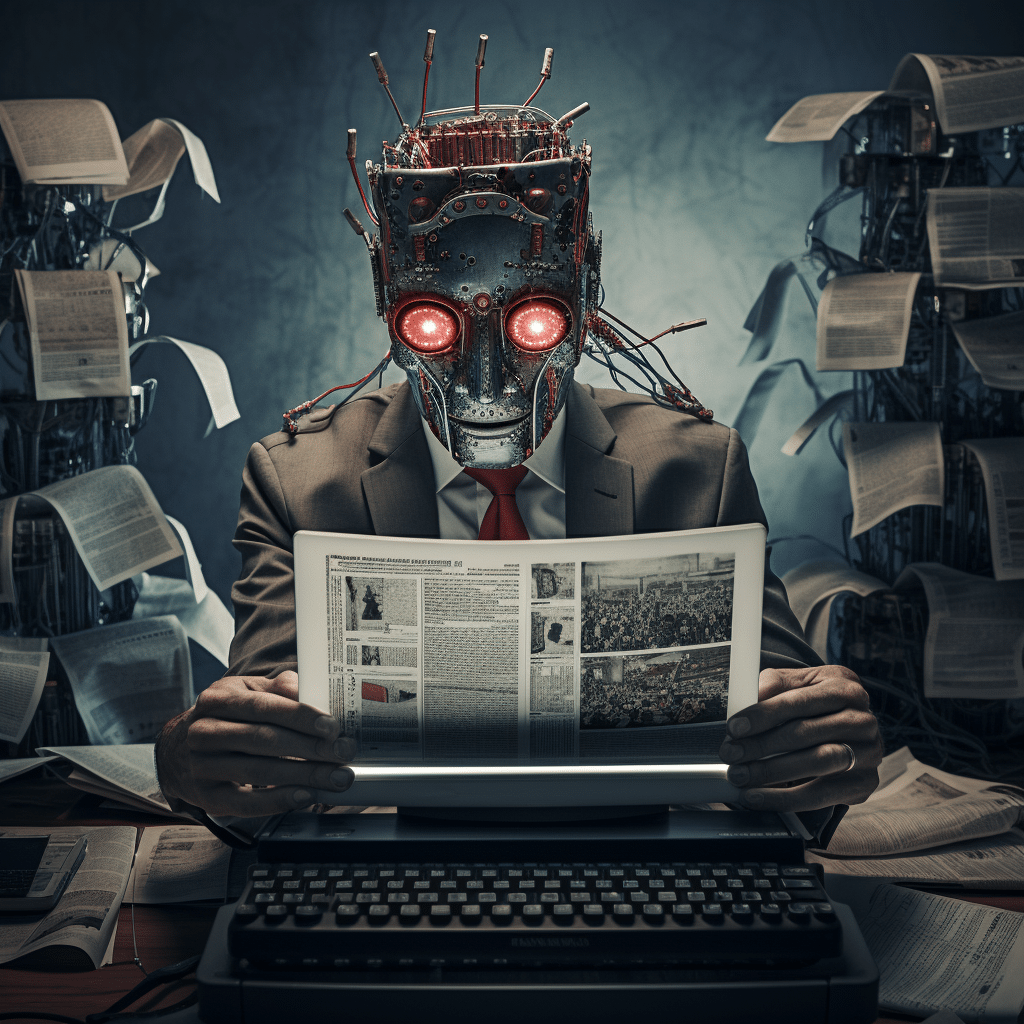
AI and Fake News: Combating Misinformation
As the internet continues to shape our daily lives, the proliferation of fake news has become a major concern. Misinformation spreads like wildfire, causing real-world consequences, damaging reputations, and influencing public opinion. AI-powered systems tackle this problem, artificial intelligence (AI) technology is playing a vital role in combating fake news.
The Power of AI
AI-powered systems have the capability to analyze vast amounts of information, detect patterns, and identify sources of fake news. Advanced algorithms process data from various sources, including social media platforms, news websites, and fact-checking organizations. By comparing information across multiple channels, these systems can determine the authenticity of news articles with a higher degree of accuracy.
“AI is revolutionizing the fight against fake news. Its ability to process enormous amounts of data and detect patterns makes it an invaluable tool in combating misinformation.”
Fact-Checking Made Efficient

Fact-checking is an essential aspect of identifying and debunking fake news. AI algorithms can automate the fact-checking process by cross-referencing claims and statements with trusted sources and databases. This automation significantly speeds up the verification process, allowing for faster dissemination of accurate information.
Recognizing Manipulated Content
In the era of advanced photo and video editing software, it has become increasingly challenging to distinguish between genuine and manipulated content. AI algorithms can analyze digital media, looking for signs of manipulation such as alterations, deepfakes, or digital artifacts. By scrutinizing metadata and visual patterns, AI systems can help identify and flag potentially misleading or doctored content.
Personalized News Recommendations
AI can also play a significant role in reducing the spread of fake news by providing personalized news recommendations. By analyzing user preferences and behavior patterns, AI algorithms can filter out unreliable or biased sources, and instead suggest content from reputable sources to users. This personalized approach helps combat the echo-chamber effect, where individuals are only exposed to information that aligns with their existing beliefs.
Embracing AI technology in the battle against fake news is crucial, but it also comes with its own challenges. AI algorithms need to be continuously refined and updated to adapt to evolving techniques used by purveyors of misinformation. Additionally, increasing public awareness about the risks of fake news and encouraging critical thinking remain essential in fighting this issue.
What are some key challenges in developing AI systems to effectively tackle the spread of fake news?
Developing AI systems to effectively tackle the spread of fake news faces several key challenges, including:
1. Data Quality: AI systems rely on large amounts of high-quality data to train and learn patterns. However, in the case of fake news, data can be subjective, biased, or intentionally misleading, making it challenging to build accurate models.
2. Labeling Authenticity: Determining the authenticity of news articles and sources is a complex task. AI models need reliable labeled data to distinguish between accurate and fake information. Developing robust labeling frameworks that consider various perspectives and biases can be difficult.
3. Understanding Contextual Cues: Fake news often leverages contextual cues, such as political or social events, to exploit emotions and manipulate readers. Teaching AI systems to accurately interpret and analyze such cues is essential to effectively detect and combat fake news.
4. Adversarial Attacks: Those spreading fake news can employ advanced techniques like adversarial attacks to fool AI systems. Generating intelligent and convincing misinformation designed to bypass AI detection algorithms poses an ongoing challenge.
5. Bias and Subjectivity: AI systems can inadvertently amplify human biases present in training data or algorithm designs. Ensuring that AI systems are fair, unbiased, and capable of recognizing and addressing misinformation across multiple perspectives is a critical challenge.
6. Evolving Strategies: The strategies and techniques utilized by those spreading fake news are continuously evolving. AI systems need to adapt and stay up-to-date with the latest tactics used by malicious actors to remain effective in identifying and countering fake news.
7. Ethical Considerations: AI systems used to tackle fake news must balance the desire to remove misinformation with respect for free speech and avoiding censorship. Ensuring transparency, accountability, and fairness in AI system design is vital to mitigate ethical concerns.
How can governments and tech companies work together to implement AI solutions that effectively combat the spread of fake news
Governments and tech companies can collaborate to implement AI solutions that effectively combat the spread of fake news by taking the following steps:
1. Developing a shared understanding
Governments and tech companies should work together to establish a shared understanding of what constitutes fake news. This can involve creating guidelines and frameworks that define fake news and set the criteria for identifying it.
2. Sharing data
Governments can provide tech companies with access to relevant data, such as information on known sources of fake news or patterns of dissemination. This data can be used to train AI algorithms to better detect and flag fake news content.
3. Enhancing AI algorithms
Tech companies can invest in AI research and development to create more sophisticated algorithms capable of identifying fake news. Governments can support these efforts through funding and grants for research projects focused on developing AI models specifically for combatting fake news.
4. Implementing AI-driven fact-checking systems
Governments and tech companies can collaborate to develop AI-driven fact-checking systems that can automatically verify the accuracy of news stories and sources. These systems would analyze the content and cross-reference it with trusted sources of information, helping users identify fake news.
5. Promoting transparency
Governments can work with tech companies to ensure transparency in the algorithms used by social media platforms and search engines. AI and Fake News: Combating Misinformation involve requiring companies to disclose how their algorithms prioritize and display news content, and how they identify and handle fake news.
6. Public awareness campaigns
Governments and tech companies can jointly run public awareness campaigns to educate users about the dangers of fake news and the importance of critical thinking. This can include sharing tips on how to identify fake news and promoting media literacy initiatives.
7. Encouraging responsible content sharing
Governments can work with tech companies to encourage responsible content sharing practices. This can involve implementing measures like labeling or warning systems to notify users when they encounter potentially fake news and promoting the sharing of trusted sources.
8. Collaboration on policy-making
Governments and tech companies should collaborate on policy-making initiatives related to fake news. AI and Fake News: Combating Misinformation can involve establishing regulatory frameworks that require tech companies to take active measures to combat fake news and setting guidelines for cooperation between the public and private sectors.
By undertaking these collaborative efforts, governments and tech companies can leverage the power of AI to effectively combat the spread of fake news and protect public information integrity.
Can AI algorithms significantly reduce the impact of misinformation on public perception and decision-making?

AI algorithms have the potential to significantly reduce the impact of misinformation on public perception and decision-making. Here’s how:
1. Identifying and flagging misinformation: AI algorithms can be trained to analyze vast amounts of data and identify patterns that indicate misinformation. These algorithms can scan news articles, social media posts, and other sources to detect false or misleading information.
2. Fact-checking and verification: AI-powered fact-checking tools can verify the accuracy of information by comparing it with reliable sources. These tools can quickly identify inconsistencies, bias, or false claims, helping to prevent the spread of misinformation.
3. Predictive analysis: AI algorithms can predict the potential impact of misinformation by analyzing patterns in data and social media trends. AI-powered systems can help anticipate and mitigate the negative consequences of false information before it spreads widely.
4. Personalized content curation: AI algorithms can personalize content recommendations based on individual preferences and interests. By promoting diverse perspectives and reliable sources, AI can counteract echo chambers and filter bubbles that contribute to the spread of misinformation.
5. Automated content moderation: AI algorithms can help detect and remove harmful or false information from social media platforms, reducing its visibility and reach. They can identify hate speech, conspiracy theories, and other types of misinformation, making platforms safer and more reliable sources of information.
While AI algorithms hold promise in reducing the impact of misinformation, they are not without limitations. AI models can have biases, and disinformation tactics are constantly evolving. Therefore, continual improvement, transparency, and human oversight are crucial to ensure the effectiveness and ethical use of AI in combating misinformation.








